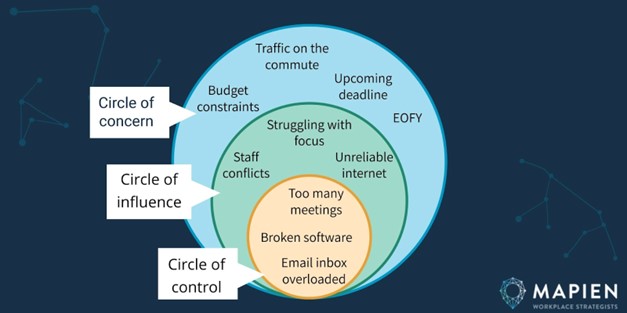
How Leaders Can Apply the Circles of Control, Influence & Concern
This is the first blog in our new series on coaching models. Sign up to our mailing list to make sure you don’t miss out on our future content.
As a leader, you likely deal with more stress than the average person. One study suggests that female leaders in executive/middle management positions are more stressed than anyone else in their organisation. It’s also fair to say that the last couple of years have come with a lot of additional stressors — so it’s understandable if you’re feeling more stressed than you used to.
Unfortunately, the health impacts of this stress can be substantial, with adults who have higher than average stress levels reporting more headaches, fatigue, nerves/anxiety, sleep disturbance, and sadness than their peers.
As a leader, managing your stress and optimising your health is critical to allow you to perform at your best and avoid burnout, while ensuring you don’t pass that stress onto your team.
The challenge is that so many sources of stress can often feel out of your control. And that can be quite stressful in itself! So, what can you do?
One model that we’ve found particularly useful for coaching many of the leaders we work with is the Circles of Control, Influence, and Concern.
What is the Circles of Control, Influence & Concern Model?

The Circles of Control/Influence/Concern is a coaching model that can help with reflecting on and visualising all the stressors or concerns a person is dealing with.
It consists of three nested circles:
- Circle of Control – Any concerns that you can directly control
- Circle of Influence – Any concerns that you can do something about
- Circle of Concern – All the other things that are causing you concern or stress
It sounds simple (and is!) but reflecting on stressors in this way can be an extremely powerful exercise for someone who feels overwhelmed and under pressure.
An Example of the Circles of Control, Influence & Concern

To better understand how this model works, take a look at the above example of one that’s already filled out.
In this situation, there are a number of things that are causing stress or concern. However, the process shows that a lot of these stressors are actually within this person’s sphere of influence or even directly able to be controlled.
By mapping each source of stress to the correct circle the situation can feel a lot less overwhelming. It’s much easier to take practical steps to start minimising overall stress. When you focus on the issues you can directly control or influence, you can start to reduce your stress levels almost right away.
Where Did This Model Originate From?
You might have come across a version of this model before if you’ve read Stephen Covey’s popular book, The 7 Habits of Highly Effective People.
The first habit he discusses in the book is ‘Be Proactive’. In a nutshell, he encourages people to take responsibility for and be proactive about the things they can influence. In other words, don’t put energy towards all the things that you’re concerned about, but instead, focus positive energy on the things you can influence or control.
The idea is that each time you’re successful with solving an issue you can control, you’ll expand your circle of control and influence. And this will allow you to tackle more of those concerns or stressors that were previously out of reach.
How Leaders Can Apply the Circles Coaching Model
Ready to apply the circles model? Work with your leadership coach or guide yourself through the process of reflecting on what your concerns are, what you can influence, and what you can control.
Step 1: Identify Your Stressors
Note down any concerns or stressors that are coming up in a specific context (for instance, at work). Identify which of these concerns matter to you, and which you find mentally or emotionally draining.

Step 2: Note Your Controllable Stressors
Out of the concerns you’ve identified, make note of the ones you can directly control. Usually, this will be anything that relates to your own thoughts, behaviours, and decisions (since you can’t control other people’s thoughts or actions). These will make up the Circle of Control, which is your smallest circle.
Step 3: Note What You Can Influence
Out of your remaining concerns, make note of those that you can exert a level of influence over. In other words, these are the issues that you can do something about, even if you can’t completely control the outcomes. These will make up your Circle of Influence, which is a little larger than (and also wraps around) your Circle of Control.
Step 4: Add the Rest
All the remaining concerns are issues that you can neither control nor influence. Example stressors might include past choices, weather, government policy, the economy, the media, public transport, and traffic. These can go into your Circle of Concern, which is our largest circle and wraps around the other two circles.
Step 5: Take Action
Now that you’ve completed your circles of concern, influence, and control, it’s time to use this tool to determine your next steps. Where should you focus your attention and energy first? Most of the time, it will make sense to start with some issues you can directly control and influence. This will help give you a sense of control and agency, while reducing your stress and achieving greater mental ease.
Bonus: Apply It To Your Team!
Once you’re confident with this model, you could guide your team through this process together, focusing on their concerns related to a specific project.
In a group setting, you might use a whiteboard to draw the three circles. Ask each member to write out any concerns they may have on sticky notes. Next, you could discuss each concern together, determining where it fits, and then placing it into the correct circle. From there, you can encourage team members to take action on any issues they can directly control or influence, working together to gradually reduce the issues or concerns.
Doing this exercise as a team has two major benefits. Firstly, you’ll bring a broader range of concerns and stressors to the surface that may have otherwise gone unnoticed or unacknowledged (but could have impacted the team or project negatively). And secondly, you’ll have a much wider sphere of influence than any one individual, with more people onboard to help tackle the team’s concerns.
Why this Coaching Model Works
This coaching model may be simple, but it can make a real difference for leaders and individuals experiencing stress or overwhelm. It can:
- Guide you to reflect on all the issues that are bothering you and contributing to your stress (consciously or subconsciously)
- Help you take a more proactive approach to managing stress
- Help you develop a more positive mindset by focusing on the things you can control
- Reduce feelings of helplessness or frustration
- Help you prioritise your efforts and energy on which problems you should work on solving first
- Help you build momentum and increase your influence as you go
If you haven’t tried this tool out yet, give it a go and see if it makes a difference to how you tackle stress!
Connect with us
Looking for leadership coaching or hands-on help with more great tools like this one to get the best out of your teams? Contact us today!

